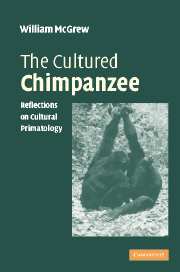Book contents
- Frontmatter
- Contents
- Preface
- Acknowledgements
- 1 Introduction
- 2 Definition
- 3 Disciplines
- 4 Creatures other than primates
- 5 Primates
- 6 Chimpanzee ethnography
- 7 Chimpanzee material culture
- 8 Chimpanzee society
- 9 Lessons from cultural primatology
- 10 Does cultural primatology have a future?
- References
- Author index
- Subject index
4 - Creatures other than primates
Published online by Cambridge University Press: 29 December 2009
- Frontmatter
- Contents
- Preface
- Acknowledgements
- 1 Introduction
- 2 Definition
- 3 Disciplines
- 4 Creatures other than primates
- 5 Primates
- 6 Chimpanzee ethnography
- 7 Chimpanzee material culture
- 8 Chimpanzee society
- 9 Lessons from cultural primatology
- 10 Does cultural primatology have a future?
- References
- Author index
- Subject index
Summary
It seems that there is a significant inverse correlation between number of legs and proficiency at social learning. The total biped, Homo sapiens, ranks first, followed by the somewhat biped (songbirds), quadruped (nonhuman primates, rodents), hexapod (ants, Reznikova, 2001), octoped, (octopus, Fiorito & Scotto, 1992), and the non-social-learning decapod (e.g. crayfish) bringing up the rear. The trend will be even stronger if those elusive near-nullipeds (cetaceans) turn out to be the most profound social learners of all. Whales do change their songs annually on a global scale (Noad et al., 2000), something that humans cannot match, even with telecommunications.
Is the relation between legs and learning nonsense? Probably, but no more so than some other claims made about culture in animal species other than those of the Order Primates. Definition again is crucial: depending on the definition of culture, only living humans (Premack & Premack, 1994) or even slime-moulds (Bonner, 1980) can be considered as culture-bearers. The former viewpoint is speciest, and exclusive; the latter is exuberantly inclusive, although the altruistic amoeba may feel aggrieved at being omitted (Strassman et al., 2000).
The conceptual confusion may come from the variety of longstanding views on the possibility of animal culture that go back at least to Morgan (1868) writing about the beaver. This hard-working denuder of landscapes and erector of dams and cunning builder of lodges would seem to be the perfect example of a niche constructor (Laland et al., 2000), yet is but a big rodent.
- Type
- Chapter
- Information
- The Cultured ChimpanzeeReflections on Cultural Primatology, pp. 50 - 62Publisher: Cambridge University PressPrint publication year: 2004



